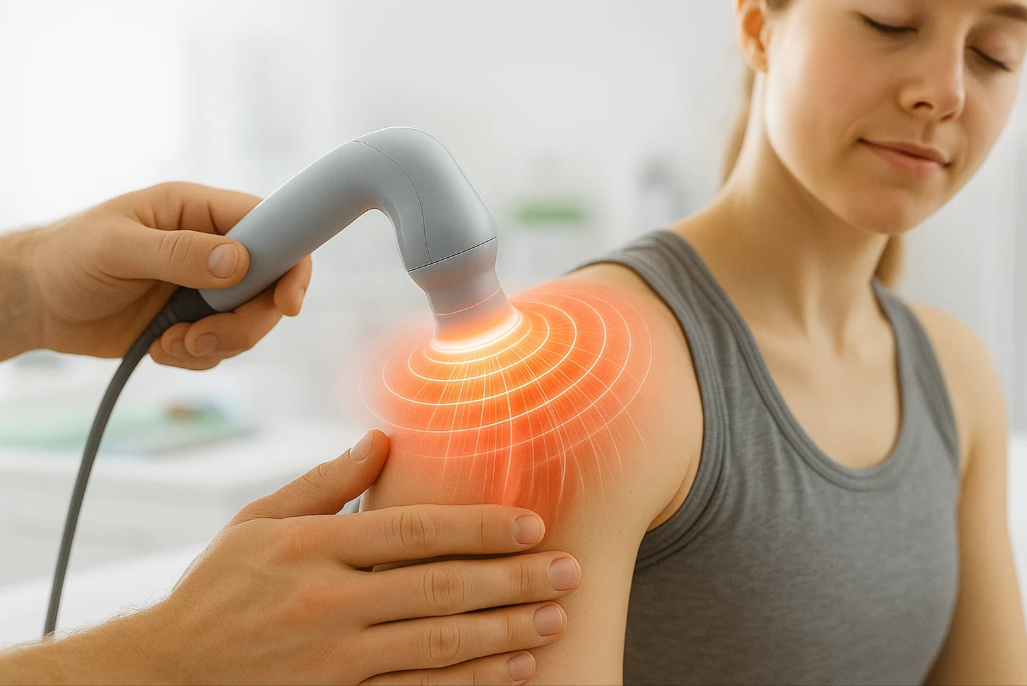In physiotherapy, we're constantly seeking innovative ways to enhance patient care and improve outcomes.
Ultrasound therapy is a prime example of this commitment. It's a non-invasive treatment that utilizes sound waves
to address a variety of conditions, from muscle strains to joint pain. But what makes this technology work? The
answer lies in a fascinating scientific principle known as the "piezoelectric effect." We will explore
the piezoelectric effect and its critical role in physiotherapy ultrasound, providing you with a clear understanding
of how this technology contributes to your well-being. We aim to empower you with knowledge, transforming
physiotherapy, one patient at a time.
The Piezoelectric Effect Explained
At its core, the piezoelectric effect is the remarkable ability of certain materials to generate an electrical charge
when subjected to mechanical stress, such as pressure or vibration. Conversely, these materials can also deform
or vibrate when an electric field is applied. It's a two-way street: pressure creates electricity, and vice versa. This
unique property is the driving force behind ultrasound therapy. The intensity of piezoelectricity varies depending
on the tissue type, like bone, cartilage, or soft tissues. For example, the piezoelectric effect will impact the design
of ultrasound parameters in different purposes, such as the stem cell preparations for regenerative medicine or
the direct therapeutic ultrasound in pain management or transcranial stimulations.
Piezoelectric Crystals: The Heart of Physiotherapy Ultrasound
Transducers
The magic of physiotherapy ultrasound begins within the transducer, the device that delivers the ultrasound
waves. At the heart of the transducer are piezoelectric crystals, typically crafted from materials like quartz or
specialized ceramics. These crystals are the key components that harness the piezoelectric effect. The crystal's
cut also influences the ultrasound wave's characteristics. When an alternating electrical current is applied to
these crystals, they rapidly expand and contract, producing high-frequency sound waves. These waves are then
transmitted through a conductive gel applied to the skin, allowing them to travel into the underlying tissues.
How Physiotherapy Ultrasound Works: Generating Therapeutic
Waves
The process of generating therapeutic ultrasound waves relies entirely on the piezoelectric effect. The ultrasound
machine sends an electrical current to the piezoelectric crystals within the transducer. As mentioned earlier,
these crystals vibrate in response, producing high-frequency sound waves. These waves travel through the gel
and into the targeted tissues. Your physical therapist will gently apply a conductive gel to the treatment area and
then carefully move the transducer head back and forth on your skin. This ensures the ultrasound waves are
delivered effectively and comfortably. The depth of penetration is a key factor in ensuring effective treatment. The
ultrasound frequency determines the depth of penetration.
Key Benefits of Ultrasound Therapy in Physiotherapy: Pain Relief and Healing
Ultrasound therapy offers a range of benefits within the scope of physiotherapy practice. One of the primary
applications is pain relief. The gentle sound waves stimulate nerve fibers, helping to ease your pain and
discomfort. Additionally, ultrasound can help to reduce inflammation and edema, further contributing to pain
reduction. Beyond pain relief, ultrasound therapy is also used to promote tissue healing. The sound waves
can increase blood flow to the treated area, delivering essential nutrients and oxygen to damaged tissues.
This enhanced circulation can accelerate the healing process for soft tissue injuries such as muscle strains,
ligament sprains, and tendonitis. Furthermore, ultrasound can improve tissue extensibility and circulation, leading
to increased mobility. Ultrasound treatment not only generates mechanical force but also electric fields due to
the piezoelectric effect, contributing to the modulation of the cells involved. A low-intensity Pulsed Ultrasound
(LIPUS) can be used for fracture repair also.
Personalizing Ultrasound Therapy: Frequency and Intensity for
Optimal Results
One of the advantages of ultrasound therapy is its adjustability. Physiotherapists can tailor the treatment
parameters, such as frequency and intensity, to meet the specific needs of each patient and their condition.
The ultrasound frequency determines the depth of penetration, while the intensity controls the amount of energy
delivered to the tissues. For example, a superficial muscle strain might be treated with a higher frequency and
lower intensity. In contrast, a deeper joint injury might require a lower frequency and higher intensity. The mode
of delivery can also be adjusted. Continuous ultrasound delivers a constant stream of energy, while pulsed
ultrasound delivers energy in short bursts, allowing for greater control over the thermal effects. This commitment
to personalized care, powered by innovation, ensures the best possible outcomes for our patients. Ultrasound
therapy is a treatment tool used by physical and occupational therapists. Ultrasound therapy, using a probe and
gel is used in a circular motion over the affected area. Ultrasound is effective in three folds. First, it increases
blood flow in the treated area. Secondly, it decreases pain from the reduction of swelling and edema. Thirdly,
the gentle massage of muscle tendons and/ or ligaments in the treated area adds no strain and scar tissue is
softened.
The Role of Tissuewave
Tissuewave is a device that utilizes ultrasound technology. It is used by physical therapists for various therapeutic
applications. The device uses the piezoelectric effect to generate ultrasound waves, which are then applied to
the patient's body to promote healing and reduce pain.
Conclusion
The piezoelectric effect is the unsung hero behind the therapeutic benefits of ultrasound therapy. This fascinating
phenomenon, where mechanical stress and electrical charge are intertwined, allows us to harness the power
of sound waves for pain relief, tissue healing, and improved function. By understanding the science behind
this technology, you can appreciate the precision and effectiveness of ultrasound therapy as a valuable tool
in physiotherapy. Remember, ultrasound therapy is just one of the many tools physiotherapists use to help
you recover and achieve your optimal physical function. It's often used in conjunction with other physiotherapy
techniques for comprehensive care. We believe in tailoring every treatment plan to your
unique needs, ensuring you receive the most effective and personalized care possible. If you're experiencing
pain or limited mobility, consult with a qualified physiotherapist to determine if ultrasound therapy is right for you.
